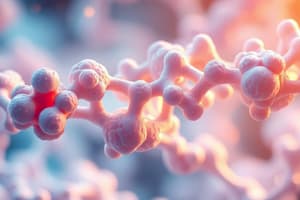Podcast
Questions and Answers
What is the characteristic feature of sucrose among the sugars mentioned?
What is the characteristic feature of sucrose among the sugars mentioned?
- Both anomeric carbon atoms are fixed in a glycosidic linkage (correct)
- It is readily oxidized
- It is a homopolysaccharide composed of single monosaccharide building blocks
- It is a polymer of α(1,4) glucose
What is the primary function of glycogen in animals?
What is the primary function of glycogen in animals?
- To provide structural support to cells
- To increase the bulk of stool
- To stimulate the intestinal movement
- To store energy in a compact form (correct)
What is the difference between starch and glycogen?
What is the difference between starch and glycogen?
- Starch is composed of only α(1,4) glucose linkages
- Glycogen is more branched than starch (correct)
- Starch has a more extensive branching pattern than glycogen
- Glycogen is found in plants, while starch is found in animals
What is the primary component of cell walls in plants?
What is the primary component of cell walls in plants?
What is the function of cellulose in the diet?
What is the function of cellulose in the diet?
What is the characteristic feature of amylose?
What is the characteristic feature of amylose?
What type of bond forms between two monosaccharides to create a disaccharide?
What type of bond forms between two monosaccharides to create a disaccharide?
Which of the following is an example of a disaccharide?
Which of the following is an example of a disaccharide?
What is the term for the carbon atom in a monosaccharide that forms a cyclic ring?
What is the term for the carbon atom in a monosaccharide that forms a cyclic ring?
What is the term for a monosaccharide that contains a reactive carbonyl group?
What is the term for a monosaccharide that contains a reactive carbonyl group?
What is the term for a monosaccharide that cannot be readily oxidized?
What is the term for a monosaccharide that cannot be readily oxidized?
How many member ring is formed in a monosaccharide?
How many member ring is formed in a monosaccharide?
What is the characteristic of monosaccharides that contain 2 monosaccharide units?
What is the characteristic of monosaccharides that contain 2 monosaccharide units?
Which of the following is an example of a polysaccharide?
Which of the following is an example of a polysaccharide?
What is the characteristic of polysaccharides in terms of their composition?
What is the characteristic of polysaccharides in terms of their composition?
What is the difference between a disaccharide and a polysaccharide?
What is the difference between a disaccharide and a polysaccharide?
Which of the following is NOT a characteristic of polysaccharides?
Which of the following is NOT a characteristic of polysaccharides?
What is the characteristic of disaccharides in terms of their composition?
What is the characteristic of disaccharides in terms of their composition?
What is the relationship between disaccharides and polysaccharides?
What is the relationship between disaccharides and polysaccharides?
Which of the following is an example of a polysaccharide found in plants?
Which of the following is an example of a polysaccharide found in plants?
Study Notes
Carbohydrates
- Carbohydrates are defined as C:H:O in a 1:2:1 ratio, and can be represented by the general formula CH2OH.
- They can be classified into three main categories: monosaccharides, disaccharides, and polysaccharides.
Monosaccharides
- Monosaccharides are the simplest carbohydrates, and can be further classified into aldoses and ketoses.
- Examples of monosaccharides include glyceraldehyde (a triose), erythrose (a tetrose), ribose (a pentose), and glucose, galactose, and fructose (hexoses).
- Monosaccharides are optically active, contain at least one asymmetric carbon (chiral center), and can exist as stereoisomers.
- Stereoisomers of monosaccharides can be classified into enantiomers, epimers, and anomers.
Enantiomers, Epimers, and Anomers
- Enantiomers are non-superimposable mirror images of each other, and can exist in D or L conformation.
- Epimers are sugar molecules that differ in configuration at only one of several chiral centers.
- Anomers are cyclic ring structures that can be formed by aldhyde or ketone groups, and can exist in α or β configurations.
Disaccharides
- Disaccharides are formed by the combination of two monosaccharides through a glycosidic bond.
- Examples of disaccharides include sucrose (glucose + fructose), lactose (galactose + glucose), and maltose (glucose + glucose).
Reducing and Non-Reducing Sugars
- Reducing sugars contain a reactive carbonyl group, are readily oxidized, and can reduce metal ions.
- Non-reducing sugars, such as sucrose, have both anomeric carbon atoms fixed in a glycosidic linkage, and are not readily oxidized.
Polysaccharides
- Polysaccharides are larger, containing hundreds of monosaccharides.
- They can be classified into homopolysaccharides (composed of a single monosaccharide building block) and heteropolysaccharides (composed of different building blocks).
- Examples of polysaccharides include glycogen, starch, and cellulose.
Glycogen and Starch
- Glycogen is the major form of stored carbohydrate in animals, composed of α(1,4) glucose linkages, and highly branched by α(1,6) linkages every 8-10 residues.
- Starch is the major form of stored carbohydrate in plants, similar in structure to glycogen but less extensively branched.
Cellulose
- Cellulose is a structural polysaccharide composed of long, straight, non-branching chains of β-D-glucose linked by β-(1-4) glucosidic bonds.
- It is insoluble in water, cannot be digested by humans, and plays an important role in the diet by increasing the bulk of stool and stimulating intestinal movement.
Studying That Suits You
Use AI to generate personalized quizzes and flashcards to suit your learning preferences.
Description
This quiz covers the different types of carbohydrates, including reducing and non-reducing sugars, polysaccharides, and their classifications.




